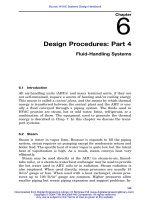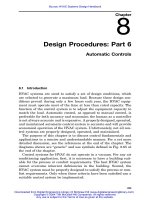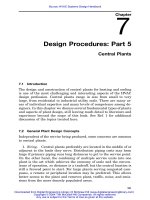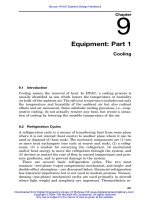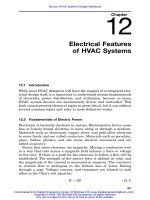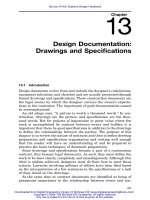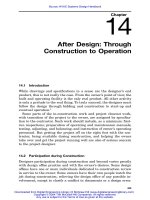Tài liệu HVAC Systems Design Handbook part 20 pdf
Bạn đang xem bản rút gọn của tài liệu. Xem và tải ngay bản đầy đủ của tài liệu tại đây (228.63 KB, 16 trang )
485
Chapter
20
Engineering Fundamentals:
Part 5
Sound and Vibration
20.1 Introduction
The HVAC designer cannot neglect consideration of the sound and
vibration generated by HVAC equipment. This chapter briefly dis-
cusses the fundamentals of sound and vibration control. References
for further study are cited at the end of the chapter.
20.2 Definitions
Sound is a form of energy, detected as a variation in pressure and
stress in an elastic or viscous medium. The traditional concept is that
sound is generated by a source and is transmitted through a path to
a receiver (Fig. 20.1). Diminishment of the sound during transmission
is called attenuation. The receiver is usually a human ear or a micro-
phone. The audible range of hearing for humans is roughly between
20 Hertz (Hz) and 20,000 Hz. Many animals have a wider range.
Lower frequencies can sometimes be felt.
Vibration is a form of energy, detected as cyclic movement in a ma-
chine or structure. Sound and vibration are mutually convertible, and
many transmission problems and solutions depend on this fact.
Noise is unwanted sound. One person’s sound may be another per-
son’s noise, e.g., heavy-metal rock music. In general, however, noise is
random sound. White noise, used for masking unwanted sound, is ran-
dom sound in the speech interference range.
Source: HVAC Systems Design Handbook
Downloaded from Digital Engineering Library @ McGraw-Hill (www.digitalengineeringlibrary.com)
Copyright © 2004 The McGraw-Hill Companies. All rights reserved.
Any use is subject to the Terms of Use as given at the website.
486 Chapter Twenty
Figure 20.1
Sound transmission.
20.3 Methods of Specifying
and Measuring Sound
There are several ways of describing the characteristics of sound:
sound power, sound pressure, intensity, loudness, frequency, speed,
and directivity.
20.3.1 Sound power
An acoustical source radiates energy in the form of sound. This acous-
tical power is expressed in watts. A watts exponential scale of sound
power has been developed. A sound power level of 10
Ϫ12
W represents
the threshold of hearing for excellent young ears. This is given the
value of 0 dB (decibels) and is the reference level for Table 20.1. Table
20.1 lists the decibel value corresponding to a given watts exponential,
together with an example of this sound power, over a scale from 0 to
200 dB.
20.3.2 Intensity and sound pressure level
Sound power cannot be measured directly but must be calculated from
pressure measurements. If an imaginary sphere is placed around a
sound source (with the source at the center of the sphere), all the
energy from the source must pass through the sphere. Power flow
through a unit area of the sphere is the intensity, expressed in watts
per unit area. Intensity varies inversely as the square of the distance
from the source. The intensity and the sound pressure level are nearly
identical numerically if proper units are used. The ASHRAE Hand-
book uses watts per square meter and micropascals (
Pa). The mea-
suring system converts the pressure to decibels, corresponding to the
sound power levels of Table 20.1.
20.3.3 Loudness and frequency
Sound may be visualized as traveling in a wave pattern similar to that
of alternating electric current (Fig. 20.2). Variation above and below
the reference is called the amplitude and determines the loudness. The
Engineering Fundamentals: Part 5
Downloaded from Digital Engineering Library @ McGraw-Hill (www.digitalengineeringlibrary.com)
Copyright © 2004 The McGraw-Hill Companies. All rights reserved.
Any use is subject to the Terms of Use as given at the website.
Engineering Fundamentals: Part 5 487
TABLE
20.1 Sound Power Outputs
* With afterburner.
†
Four jet engines.
‡
Four propeller engines.
SOURCE
: Copyright 1987, American Society of Heating, Refrigerating and Air Conditioning
Engineers, Inc., www.ashrae.org. Reprinted by permission from ASHRAE Handbook, 1987
Systems and Applications; 2001 Fundamentals, Chap. 7, Table 2, is similar.
Figure 20.2
Wavelength and amplitude of sound.
distance from one wave peak to the next is the wavelength, the recip-
rocal of which is the frequency or pitch of the sound. Frequency is
measured in cycles per second (cps). The term hertz (abbreviated Hz)
is used instead of cycles per second. Figure 20.2 represents a pure
tone—one single frequency. Most sound is made up of several fre-
quencies (tones), with each frequency having a different loudness. For
Engineering Fundamentals: Part 5
Downloaded from Digital Engineering Library @ McGraw-Hill (www.digitalengineeringlibrary.com)
Copyright © 2004 The McGraw-Hill Companies. All rights reserved.
Any use is subject to the Terms of Use as given at the website.
488 Chapter Twenty
example, air noise in a duct is made up of several high-frequency tones
generated by turbulence of the air due to fittings and obstructions as
well as that due to straight-line flow and friction against duct walls.
This air noise will usually be accompanied by sound transmitted from
the fan, with a predominant frequency which is a function of the fan
speed and number of blades.
20.3.4 Frequency spectrum
A good human ear can hear, and distinguish, a wide range of
frequencies—from a low of about 20 Hz to a high of about 20,000 Hz.
For the purposes of analysis, this range is divided into several octaves.
Two tones are said to be an octave apart when the frequency of one is
twice that of the other. A common example is the musical octave on
the piano or other instrument. On the musical scale, the A below mid-
dle C has a frequency of 440 Hz. A sound-level measuring instrument
is usually equipped with filters so that the sound level of each octave
band, or in some cases
1
⁄
3
octave band, can be measured. The com-
monly used scale for octave and
1
⁄
3
octave bands is shown in Table
20.2.
The quality of a sound is determined by the harmonics (other fre-
quencies) and their relationship to the dominant frequency. The tonal
quality of each of the various musical instruments is determined by
the harmonics typical of that instrument.
20.3.5 Speed and directivity
The speed of sound varies with the medium used as the path and is
a function of that medium’s density and modulus of elasticity. The
speed of sound is highest in high-density materials such as steel
(16,000 ft/s) and water (5000 ft / s). In air at room temperature and
sea level pressure, it is about 1100 ft / s.
Directivity means that a real sound source does not generate a uni-
form pattern; sound intensity varies with direction and distance from
the source. This can be particularly noticeable when the sound is gen-
erated as a result of vibration of the source. In the direction of vibra-
tional movement, the sound level will be much higher than in other
directions.
20.4 Sound and Vibration Transmission
In HVAC practice, the sound and vibration sources are the elements
of the HVAC system: fans, pumps, compressors, air flowing in ducts,
and water and steam flowing in pipes. The paths for transmission are
Engineering Fundamentals: Part 5
Downloaded from Digital Engineering Library @ McGraw-Hill (www.digitalengineeringlibrary.com)
Copyright © 2004 The McGraw-Hill Companies. All rights reserved.
Any use is subject to the Terms of Use as given at the website.
Engineering Fundamentals: Part 5 489
TABLE
20.2 Center Approximate Cutoff Frequencies for Octave and One-Third
Octave Band Series Frequency, Hz
SOURCE
: Copyright 1997, American Society of Heating, Refrigerating and Air Conditioning
Engineers, Inc., www.ashrae.org. Reprinted by permission from ASHRAE Handbook, 1997
Fundamentals, Ch. 7, Table 1. (Original source: ANSI Standard 51.6.)
the ducts, pipes and the building structure. The receivers are the peo-
ple in the building or vibration-sensitive equipment.
20.4.1 Transmission through ducts
The sound transmitted through ducts comes from at least three
sources: fan room equipment, air noise generated in the ducts, and
sound generated outside the ducts and transferred through the duct
walls.
Some fan room equipment noise is in the third category. Noise from
the fan is transmitted directly through the ducts and is dominated by
a frequency determined by the fan speed and number of fan blades.
Air noise is generated as part of the energy loss due to friction; more
noise is generated at points of turbulence such as elbows, transitions
Engineering Fundamentals: Part 5
Downloaded from Digital Engineering Library @ McGraw-Hill (www.digitalengineeringlibrary.com)
Copyright © 2004 The McGraw-Hill Companies. All rights reserved.
Any use is subject to the Terms of Use as given at the website.
490 Chapter Twenty
Figure 20.3
Sound transmission through structure.
or branches, and particularly dampers. Poorly constructed lightweight
dampers have a tendency to vibrate. Dampers at terminal units, e.g.,
VAV boxes, may be noisy if the entering air pressure is too high. Sound
is always generated when a fluid passes from a high-pressure region
to a lower-pressure one. Improperly braced duct sidewalls may flex in
resonant motion, creating a rumbling sound.
All these things apply also to the return air system, and because
the return air path is usually shorter than the supply air path, the
return air duct /plenum system is often an acoustic problem.
20.4.2 Transmission through
the building structure
Most equipment-generated sound—from fans, pumps, and com-
pressors—is transmitted through the building structure as vibration
and is heard or felt by the receiver. The path may not be obvious and
may be complex, as in Fig. 20.3. In this real example, a refrigeration
compressor in the basement of a church was properly isolated from
the floor. But vibration energy was transmitted several feet through
the air to a 12-in concrete wall. The wall had a natural frequency
Engineering Fundamentals: Part 5
Downloaded from Digital Engineering Library @ McGraw-Hill (www.digitalengineeringlibrary.com)
Copyright © 2004 The McGraw-Hill Companies. All rights reserved.
Any use is subject to the Terms of Use as given at the website.
